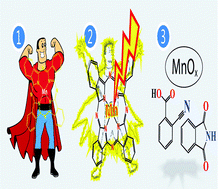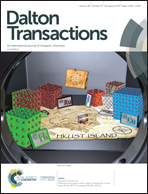A manganese(ii) phthalocyanine under water-oxidation reaction: new findings†
Abstract
Phthalocyanines are a promising class of ligands for manganese because of their high binding affinity. This effect is suggested to be an important factor because phthalocyanines tightly bind manganese and stabilize it under moderate conditions. The strong donor power of phthalocyanine is also suggested as a critical factor to stabilize high-valent manganese phthalocyanine. Herein, a manganese(II) phthalocyanine, which is stable under moderate conditions, was investigated under harsh electrochemical water oxidation. By scanning electron microscopy, transmission electron microscopy, energy dispersive spectrometry, X-ray diffraction, extended X-ray absorption fine structure analysis, X-ray absorption near edge structure analysis, chronoamperometry, magnetic measurements, Fourier-transform infrared spectroscopy, and electrochemical methods, it is shown that manganese phthalocyanine, a known molecular complex showing good stability under moderate conditions, could not withstand water oxidation catalysis and ultimately is altered to form catalytic oxide particles. Such nanosized Mn oxides are the true catalyst for water oxidation. Besides, we try to go a step forward to find an answer as to how Mn oxides form on the surface of the electrode.



 Please wait while we load your content...
Please wait while we load your content...